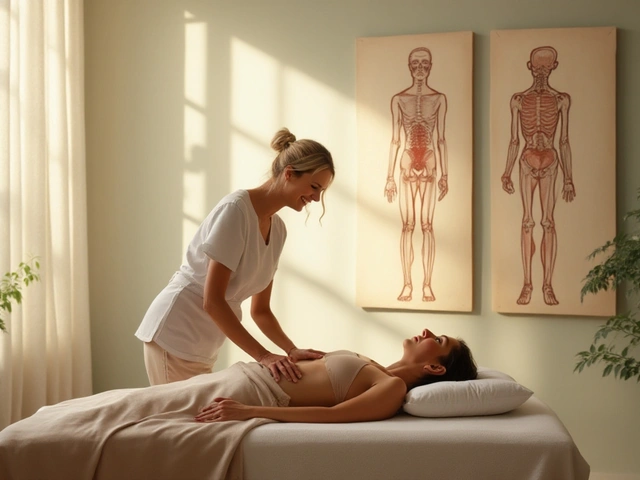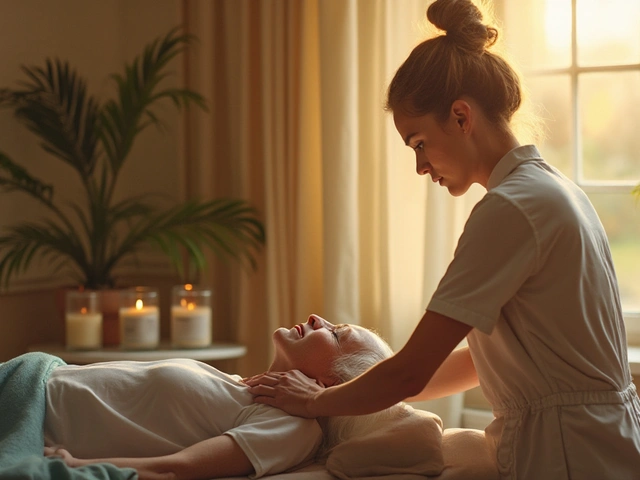Anxiety management: Simple ways massage and movement calm your mind
Feeling wired and can't switch off? Anxiety shows up in muscles as much as in thoughts. The good news: specific touch and gentle movement can lower the fight-or-flight response fast. Here I share clear, practical ways - breath, pressure points, and hands-on sessions - that you can use right away or discuss with a therapist.
Quick, practical techniques
Start with your breath. Slow exhale lengths calm the nervous system; try 4 seconds in, 6 seconds out for a minute or two. Add acupressure: press the point between your eyebrows for 30 seconds, then massage the base of your skull with thumb circles. These small steps lower tension and prepare your body for deeper work.
Try self-massage with a tennis ball against a wall to ease upper back knots. Tight shoulders and neck feed anxiety - releasing trigger points there often reduces that tight, panicky feeling. Warm stone or hot-towel packs on the chest and neck also soothe the nervous system when you need immediate relief.
Move gently. Feldenkrais and Hellerwork teach slow, mindful movement that rewires how your body holds stress. Even ten minutes of mindful shoulder rolls, chest opens, and tiny spine twists helps the brain accept a calmer posture. Ortho-Bionomy techniques use tiny, painless motions that tell your body it's safe - that message is powerful for anxiety.
How to pick a session
Different hands, different results. If you want firm pressure and fast muscle relief, trigger point or Amma massage can help with chronic tension. For a soothing session focused on breath and safety, try Lomi Lomi, warm-stone therapy, or polarity therapy. If you prefer a gentle, learning approach that changes movement patterns, look for Feldenkrais or Hellerwork practitioners.
Talk with the therapist before your first visit. Say outright you're managing anxiety and ask how they adapt sessions - do they use slower rhythms, shorter sessions, or grounding techniques? If touch feels overwhelming, blind massage therapists and palliative massage experts are trained to work with sensitivity and emotional needs.
Finally, build small habits. Schedule a weekly tension check with acupressure or a short Feldenkrais sequence. Combine massage sessions with breath practice and a short walk to lock in calm. Anxiety doesn't vanish overnight, but consistent body-based tools change how your system responds to stress.
Five-minute routine: Sit tall, breathe 4:6 for 60 seconds, press third-eye and hold 30s, roll shoulders ten times, do neck glide each side five slow reps, place warm towel on chest for one minute, end with grounding: press feet into floor and name three things you feel. Repeat daily or before stressful events. If a technique increases dizziness or panic, stop and try gentle breathing alone. Keep a short notes log to track which methods calm you fastest - that helps pick the best combo for long-term anxiety management.
Start small, test what works, and give your body time to adapt to changes today.
Want more? Our articles on acupressure, Amma, warm-stone therapy, and Feldenkrais offer step-by-step tips and real session expectations to help you choose the best path for steady relief.

The Role of Shiatsu in Managing Anxiety and Depression
Hi there! I just posted a new blog about the fascinating role of Shiatsu in managing both anxiety and depression. As a holistic healing technique, Shiatsu has much to offer if you're fighting these mental health challenges. By applying pressure to various points on the body, it may aid in balancing your internal energy to restore emotional harmony. Do pay a visit if you’d like to learn more and explore the potential positive effects of Shiatsu in-depth.
Categories
- Health and Wellness (148)
- Alternative Therapies (86)
- Massage Therapy (40)
- Travel and Culture (15)
- Beauty and Skincare (9)
- Holistic Health (8)
- Health and Fitness (5)
- Spirituality (5)
- Other (2)
- Personal Development (2)
Popular Articles



